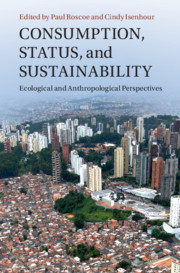Book contents
- Consumption, Status, and Sustainability
- New Directions In Sustainability And Society
- Consumption, Status, and Sustainability
- Copyright page
- Contents
- Figures
- Tables
- Contributors
- Preface
- 1 Standing Out, Fitting In, and the Consumption of the World
- Part I Status Competition and Hierarchy in Human Societies
- Part II Variability in Status Consumption
- Part III Continuity and Discontinuity
- Part IV Bending the Curve
- 10 The Higher Monkey Climb
- 11 Ecological Routes to Social Status and Urban Inclusion
- 12 Making the Market Work
- 13 Conclusion
- Index
- References
10 - The Higher Monkey Climb
Shame as a Tool in Seeking a Sustainable World
from Part IV - Bending the Curve
Published online by Cambridge University Press: 30 July 2021
- Consumption, Status, and Sustainability
- New Directions In Sustainability And Society
- Consumption, Status, and Sustainability
- Copyright page
- Contents
- Figures
- Tables
- Contributors
- Preface
- 1 Standing Out, Fitting In, and the Consumption of the World
- Part I Status Competition and Hierarchy in Human Societies
- Part II Variability in Status Consumption
- Part III Continuity and Discontinuity
- Part IV Bending the Curve
- 10 The Higher Monkey Climb
- 11 Ecological Routes to Social Status and Urban Inclusion
- 12 Making the Market Work
- 13 Conclusion
- Index
- References
Summary
Rich countries and their elites emit most of the greenhouse gases responsible for global climate change. Why should the poor and middle classes cut their emissions while privileged elites continue their irresponsible behavior toward the common good? This chapter draws on economic anthropology and treats the atmosphere as common property, suggesting some ways of controlling the free riding of the super wealthy.
- Type
- Chapter
- Information
- Consumption, Status, and SustainabilityEcological and Anthropological Perspectives, pp. 249 - 271Publisher: Cambridge University PressPrint publication year: 2021

